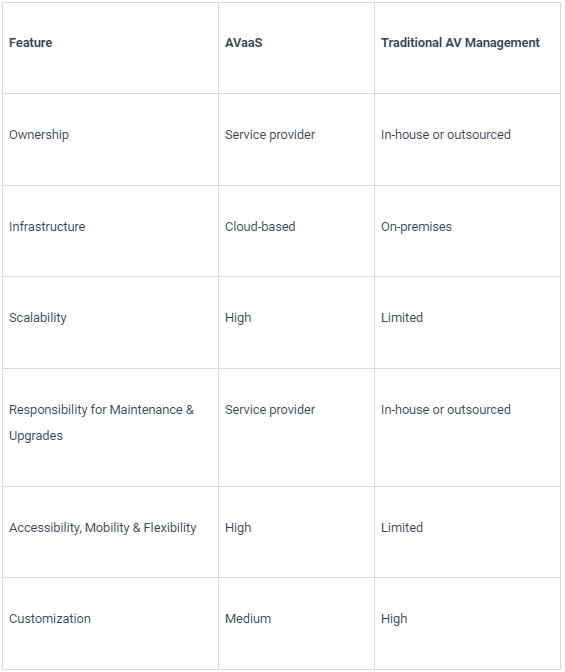Audiovisual (AV) technology and its associated management have advanced significantly in recent years. One of the most significant developments in this area has been the rise of AV as a Service (AVaaS), a reality that is affording many forward thinking organizations a raft of benefits.
Not familiar with AVaaS? It’s a service which provides AV equipment, software, and support on a subscription basis. The service provider looks after the management of the hardware, and software, including updates, maintenance, and technical support. Such a setup removes the need for the organization’s IT and/or AV teams to handle these aspects, freeing them up to focus on other projects.
In this blog, we’ll look at AVaaS vs. traditional AV management services, outlining the key similarities and differences, as well as the pros and cons of each, so you can make an informed decision as to which option is right for your organization.
Key Similarities & Differences Between AVaaS and Traditional AV Management
Here is a quick overview of the differences and similarities between various features of AVaaS and traditional AV management solutions:
Benefits of AV as a Service
Better Scalability and Flexibility
Two of the most significant benefits of AVaaS are its scalability and flexibility. Cloud-based elements mean that organizations can add functionality and capacity, without spending time and money purchasing and installing new hardware, allowing businesses to easily scale their AV systems up or down based on their changing needs.
AVaaS Is Often More Cost-Effective For Businesses With Variable AV Needs
AVaaS is particularly cost-effective for businesses with variable AV needs. Instead of committing to the ownership of a fixed asset, your AV equipment is provided on a subscription basis, which sees you only paying a predictable, recurring fee for what you need. This makes it easy for businesses to manage costs and avoid the unnecessary expenses associated with having equipment that’s not being fully utilized.
Limitations of AV as a Service
Businesses may have security concerns about storing their data off-premises and in the cloud. AVaaS providers are addressing these concerns by providing secure, cloud-based solutions that use industry-standard encryption and authentication mechanisms. Managed services providers have invested significant sums in their infrastructure and staff to ensure everything is as secure as possible.
Benefits of Traditional AV Services
Local Support
One of the primary benefits of traditional AV management services is that they provide local support and customization options. Businesses can work directly with their AV management provider to design and implement a customized AV solution that meets their specific needs. Additionally, local support means that businesses can quickly resolve any issues with their AV equipment, as reporting a fault can often be done in person.
Customization Options
Traditional AV management services can be a good fit for businesses with very specific AV needs, such as those in the healthcare or financial sectors. Organizations in these industries may have unique AV requirements, such as specialized equipment or regulatory compliance that can be difficult to meet with an off-the-shelf solution.
Drawbacks of Traditional AV Services
Often Higher Costs
Traditional AV management services can be expensive for businesses as they often require a significant capital expenditure (CapEx) investment in equipment. This equipment must be purchased, installed, and maintained by the business, adding to the overall cost of ownership. Additionally, many businesses still need to commit to a fixed contract with a traditional AV management service provider, which may limit their ability to scale their AV needs up or down in the future.
Limited Scalability
In addition, traditional AV management services may limit an organization’s ability to adopt new technologies and adapt to changing needs. Since businesses own their AV equipment, they must bear the cost of upgrading or replacing outdated equipment. This can be particularly challenging for businesses with limited budgets or those that are rapidly growing.
Choosing the Right Audio Visual Solution For Your Organization
When evaluating your AV management needs, you should consider factors such as your budget, IT infrastructure, and future growth plans. For businesses with variable AV needs or limited budgets, AVaaS is likely the best option. For organizations that are rapidly growing or expanding, the scalability of AVaaS is going to be more appealing.
In contrast, organizations with very specific AV requirements, may benefit from traditional AV management services. Likewise, businesses in sectors that have strict regulatory requirements may require a bespoke, on-premises solution.
Consult With An AV Expert At Yorktel To Learn More
With the shift from on-premises to cloud-based, AV services, such as Yorktel’s AV as a Service, are now more agile, more affordable, and more scalable than ever. By leveraging AVaaS, you can avoid the upfront costs and ongoing maintenance expenses associated with traditional AV management services, while also enjoying the benefits of remote monitoring and management.
Contact Us today to find out more about our AV managed service offerings and discover how we can help you realize all the benefits associated with taking advantage of AVaaS.

